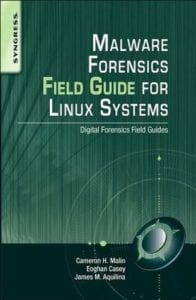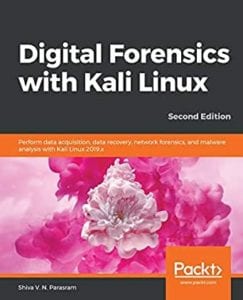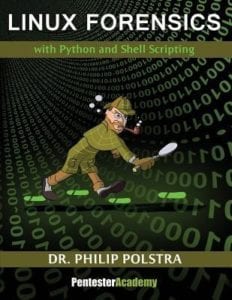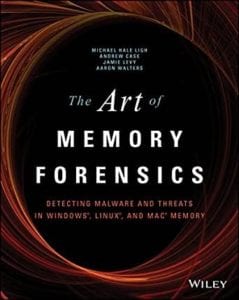This article reviews the top five best Linux forensics books. Whether you want to investigate a Linux system (for whatever reason!) or get a grip over how Linux works under the covers, these books will keep you updated. We selected these books based on ratings, recommendations, and positive public sentiment.
Let’s get to the books!
1. Practical Forensic Imaging: Securing Digital Evidence with Linux Tools (1st Edition) by Bruce Nikkel

This book elucidates how to perform forensic imaging of magnetic HDDs, optical discs, SSDs & flash drives, magnetic tapes, and other legacy technologies. It deals with how to protect the attached evidence media from unintentional modification. It further teaches you the management of large forensic image files, image format conversion, image compression, storage capacity, image splitting, duplication, secure transfers, and storage, & secure disposal. Preserve, collect, and verify evidence integrity with cryptographic, piecewise hashing, public key signatures, and RFC-3161 timestamping. Moreover, it explains working with the latest drive and interface technologies such as NVME, SATA Express, 4K-native sector drives, SAS, SSHDs, UASP/USB3x, and Thunderbolt, etc.
With its focus on digital forensic acquisition and evidence preservation, this book is a valuable resource for experienced digital forensic investigators wanting to further enhance their Linux forensics skills. We call it a must-have reference guide for every digital forensics lab. However, you should be comfortable with the command line Linux. Otherwise, it will fly over your head.
Buy Here: Amazon
About the Author:
Bruce Nikkel is a Ph.D. in network forensics and works as the head of the Cybercrime Intelligence & Forensic Investigation team at a Switzerland-based global financial institution. Here he has managed IT forensics since 2015. Also, he has published research on various topics related to Linux forensics.
2. Digital Forensics With Kali Linux (Second Edition) by Shiva V.N. Parasram

The book also introduces you to powerful tools like (the DFF and Autopsy automated Forensic suites) that will take your forensic capabilities up a notch to the professional level. By the end of this fantastic book, you will have had hands-on experience implementing all the pillars of digital forensics—acquisition, extraction, analyses, and presentation using Kali Linux tools. This book is targeted at security analysts, forensics and digital investigators, or other stakeholders interested in learning digital forensics using Kali Linux. Basic knowledge of Kali will be an added advantage, but it’s not necessary.
Buy Here: Amazon
About the Author:
Shiva V. N. Parasram is the Executive Director and CISO of the Computer Forensics and Security Institute, specializing in forensics, penetration testing, and advanced cybersecurity training. As the only Certified EC-Council Instructor in the Caribbean region, he has trained hundreds in CCNA, CND, CEH, ECSA, CHFI, and CCISO, among other certifications. He has authored two books and delivered countless lectures worldwide.
3. Linux Forensics by Philip Polstra

The author further shows how to leverage Python, shell scripting, and MySQL to efficiently analyze a Linux system. While you will have a strong understanding of Python and shell scripting by the time you complete this book, no prior knowledge of these languages is assumed. Balancing masterfully between theory and practice, Linux Forensics contains extensive coverage of Linux ext2, ext3, and ext4. A great collection of Python and shell scripts for creating, mounting, and analyzing different filesystem images are also presented in this book. Discussions of advanced attacks and malware analysis round out the book in the final chapters. Unfortunately, we found that some of the forensic image links provided in the book are broken, and there have been no corrections so far. But even then, Linux Forensics is an excellent asset for anyone wanting to better understand the Linux Internals and start their journey towards mastering Linux forensics.
Buy Here: Amazon
About the Author
Dr. Philip Polstra (aka Infosec Dr. Phil) is a Digital Forensics professor at the Bloomsburg University of Pennsylvania. He has written extensively in the field of Hacking, Penetration Testing, Digital Forensics (Both Linux and Windows. He has appeared at DEFCON, 44CON, BlackHat, B-sides, GrrCON, and spoken at top conferences worldwide, usually on forensics and hardware hacking.
4. Malware Forensics Field Guide for Linux Systems by Cameron H. Malin, Eoghan Casey, and James M. Aquilina

PDAs and the images, spreadsheets, and file types are stored on these devices.
Chapters cover Malware incident response – examination on live system and volatile data collection; analyses of physical and process memory dumps for identifying malware artifacts; post-mortem forensics – extracting Malware and linked artifacts from Linux-based systems; different legal considerations (relevant only to US courts); file identification and profiling initial analysis of a suspected file; and analysis of a suspect host. This book is short, raw, sweet, and to the point. It will appeal to beginner and mid-level computer forensic investigators and digital analysts.
Buy Here: Amazon
About the Authors
The authors are digital forensics professionals and experts in investigating and evaluating malicious code. They have written multiple books together and in an individual capacity. Mr. James M. Aquilina is currently an Advisor to the Board of Directors at The Crypsis Group and a former federal prosecutor. Mr. Cameron H. Malin assists the FBI in cases of computer intrusion and malware code matters. Eoghan Casey is associated with the University of Lausanne, Switzerland, and has written extensively on topics such as data breaches, digital frauds, crimes, and identity theft.
5. The Art of Memory Forensics: Detecting Malware and Threats in Windows, Linux, and Mac Memory by Michael Hale Ligh, Jamie Levy and Aaron Walters

Today malware and security breaches are more sophisticated, and the volatile memory is often overlooked and neglected as part of the incident response process. The Art of Memory Forensics explains technological innovations in digital forensics to help bridge this gap. It covers the most popular versions of Windows, Linux, and Mac. Although it was released back in 2014 and some of the content mentioned here feels dated, The Art of Memory is an absolute memory forensics bible. It is essential for anyone performing memory analyses. PS: this book is dense, and prior knowledge of computer OS internals comes in handy.
Buy Here: Amazon
About the Authors:
Experts in the fields of Malware, security, and digital forensics, the writers work with various educational and professional institutes around the globe. They have authored several books, peer-reviewed conference publications (at OMFW, CEIC, IEEE, etc.), and research papers on digital forensics. They are also avid contributors to the open-source Computer Forensics community.
Final Thoughts
Digital Forensics is a vast field and there are numerous good books available in the market. This article attempted to review only the best Linux forensics books. Some books mentioned above are intended for beginners, while others focus more on advanced concepts. Choose one according to your educational background and expertise level. And don’t forget to let us know what you think in the comments below.
Thank you for reading!
